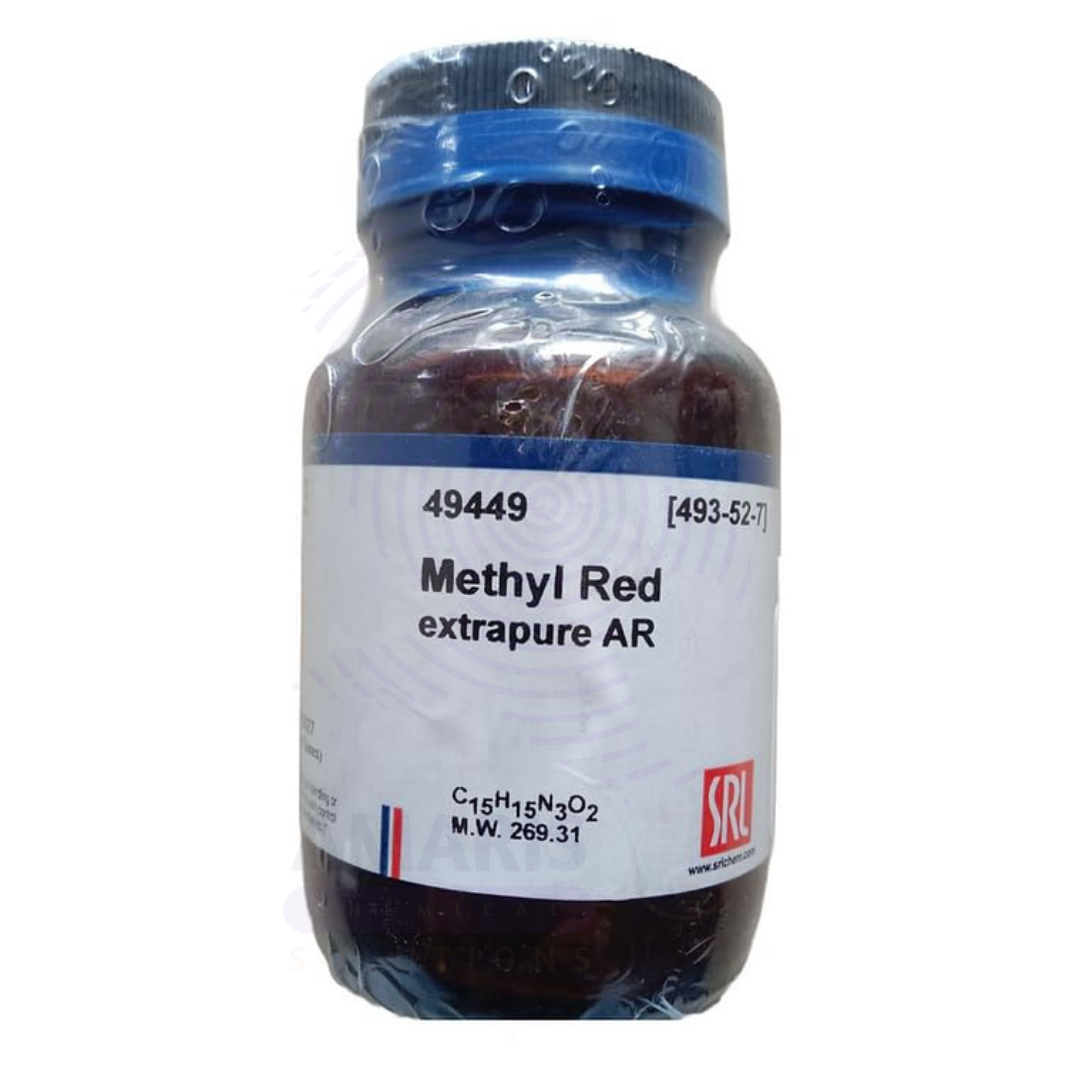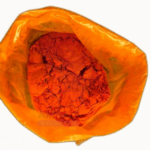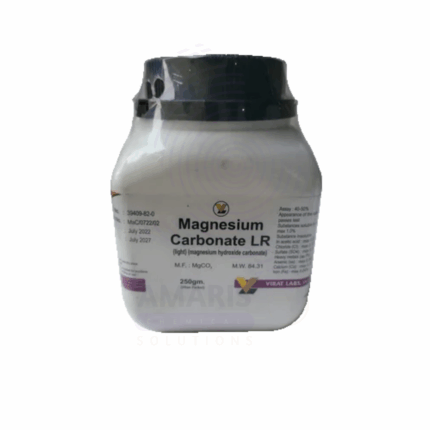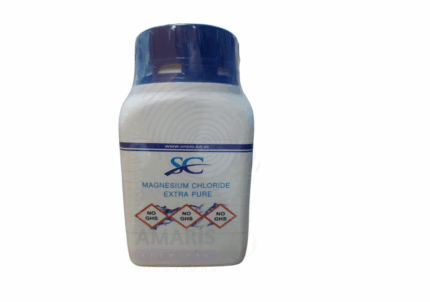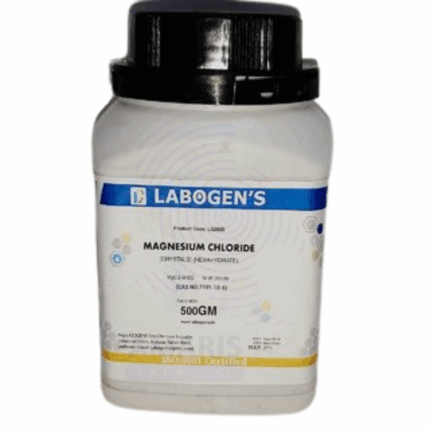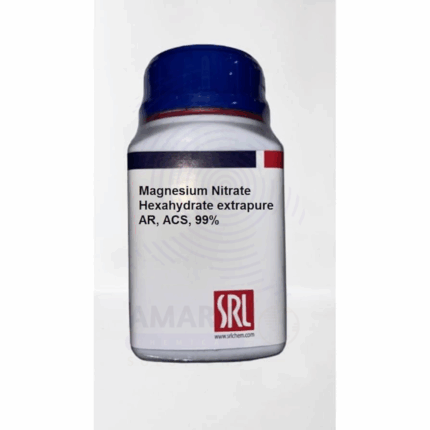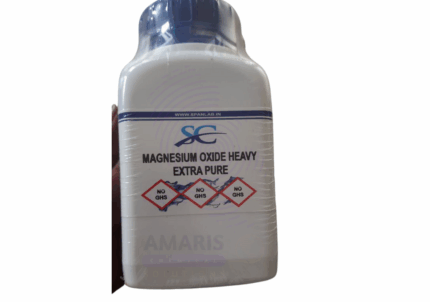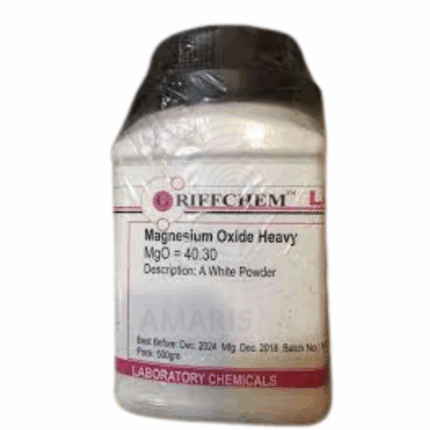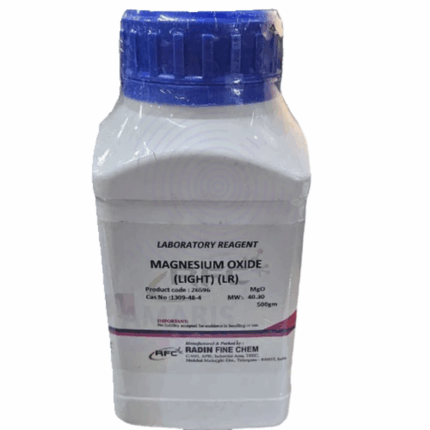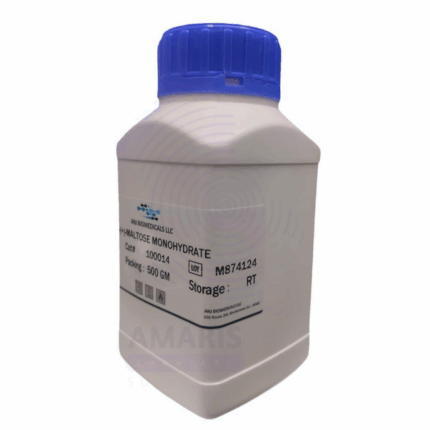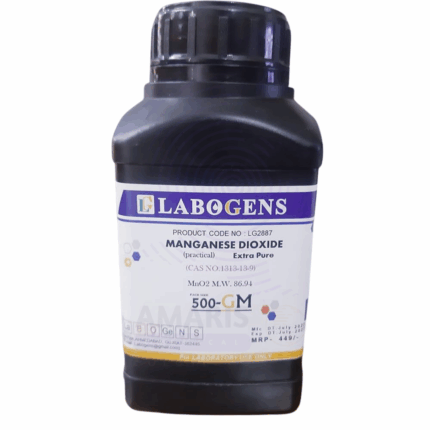Methyl Red Solution Extra Pure
$ 19.00 Original price was: $ 19.00.$ 18.89Current price is: $ 18.89.
Methyl Red Solution Extra Pure is a ready-to-use, high-purity pH indicator solution widely used in laboratories for acid-base titrations and biochemical assays. It changes color from red at pH below 4.4 to yellow above pH 6.2, making it highly effective in detecting pH shifts with clear visual transitions. This solution is particularly valuable in analytical chemistry, microbiology (such as the methyl red test in bacterial identification), and educational experiments. Its extra pure grade ensures consistent performance, high accuracy, and minimal impurities, making it suitable for precise scientific applications.
Methyl Red Solution Extra Pure
Primary Uses:
- pH Indicator Solution – Ready-to-use liquid indicator for acid-base titrations, especially effective in the pH range of 4.4 (red) to 6.2 (yellow).
- Microbiological Testing – Used directly in the Methyl Red (MR) Test to detect mixed acid fermentation by enteric bacteria (e.g., E. coli).
Secondary Uses:
- Teaching and Demonstration – Convenient for laboratory education on pH and indicators due to its visible color change.
- Buffer System Monitoring – Employed in experiments involving buffer solutions that operate near the pH transition range of methyl red.
| PACK SIZE |
500ml |
|---|
1. Basic Identification Attributes
- Chemical Name: Methyl Red Solution
- Active Ingredient: Methyl Red (C₁₅H₁₅N₃O₂)
- Typical Concentration: 0.02% to 0.1% Methyl Red in ethanol or aqueous ethanol
- CAS Number (for Methyl Red): 493-52-7
- Molecular Weight (Active): 269.30 g/mol
- Appearance: Red to orange liquid
- Odor: Alcoholic, depending on solvent
- Solubility: Miscible with water and ethanol
- Grade: Extra Pure
- pH Range (Indicator Function):
- Red at pH < 4.4
- Yellow at pH > 6.2
2. Safety & Hazard Attributes
- GHS Classification (based on ethanol solvent):
- Flammable Liquid (Category 2)
- Eye Irritant (Category 2)
- Skin Irritant (Category 2)
- Hazard Statements:
- H225: Highly flammable liquid and vapor
- H315: Causes skin irritation
- H319: Causes serious eye irritation
- Precautionary Statements:
- P210: Keep away from heat/sparks/open flames—No smoking
- P280: Wear protective gloves/protective clothing/eye protection
- P305+P351+P338: IF IN EYES: Rinse cautiously with water
- PPE Required:
- Gloves
- Lab coat
- Eye protection
- Use under fume hood for large volumes
- First Aid:
- Skin/Eye Contact: Rinse immediately with water
- Inhalation: Move to fresh air
- Ingestion: Do not induce vomiting; seek medical help
- Fire Hazards:
- Flammable—Keep away from ignition sources
- Extinguishing Media: CO₂, dry chemical, alcohol-resistant foam
3. Storage & Handling
- Storage Conditions:
- Store in tightly closed amber container
- Keep in a cool, well-ventilated area
- Keep away from sources of ignition and incompatible materials (oxidizers)
- Handling Tips:
- Avoid inhalation, skin contact, and ingestion
- Use in a well-ventilated area
4. Laboratory Applications
- Primary Uses:
- pH indicator in titrations (acid–base reactions)
- Commonly used in the MR-VP (Methyl Red-Voges Proskauer) test in microbiology
- Secondary Uses:
- Educational chemistry kits and laboratory demonstrations
- Color reference in analytical and buffer preparation
SAFETY PRECAUTIONS
Personal Protective Equipment (PPE):
- Wear a lab coat, nitrile gloves, and chemical splash goggles.
- Use in a fume hood to minimize inhalation exposure.
Handling:
- Avoid contact with skin, eyes, and clothing.
- Prevent spillage and inhalation of vapors.
- Ensure good ventilation during use.
- Wash thoroughly after handling.
Storage:
- Store in a cool, dry, and well-ventilated area.
- Keep the container tightly closed and away from direct sunlight and heat sources.
- Do not store near oxidizing agents.
FIRST AID MEASURES
Inhalation:
- Move the person to fresh air immediately.
- Seek medical attention if breathing difficulties occur.
Skin Contact:
- Rinse skin thoroughly with soap and water.
- Remove and wash contaminated clothing.
- Seek medical advice if irritation or redness develops.
Eye Contact:
- Rinse cautiously with plenty of water for at least 15 minutes.
- Remove contact lenses if present and easy to do.
- Continue rinsing and seek medical attention.
Ingestion:
- Rinse mouth with water.
- Do not induce vomiting.
- Seek immediate medical help.
FIRE FIGHTING MEASURES
Flammability:
- Solution may contain flammable solvents depending on formulation.
Extinguishing Media:
- Use dry chemicals, carbon dioxide (CO₂), or alcohol-resistant foam.
- Water spray may be used to cool containers.
Hazardous Combustion Products:
- May emit carbon oxides and nitrogen oxides upon combustion.
Firefighter Protection:
- Wear self-contained breathing apparatus (SCBA) and full protective gear.


 Preservatives(food)
Preservatives(food) Flavor Enhancers
Flavor Enhancers Acidulants
Acidulants Sweeteners
Sweeteners Antioxidants
Antioxidants Colorants(food)
Colorants(food) Nutraceutical Ingredients (food)
Nutraceutical Ingredients (food) Nutrient Supplements
Nutrient Supplements Emulsifiers
Emulsifiers
 Collectors
Collectors Dust Suppressants
Dust Suppressants Explosives and Blasting Agents
Explosives and Blasting Agents Flocculants and Coagulants
Flocculants and Coagulants Frothers
Frothers Leaching Agents
Leaching Agents pH Modifiers
pH Modifiers Precious Metal Extraction Agents
Precious Metal Extraction Agents
 Antioxidants(plastic)
Antioxidants(plastic) Colorants (Pigments, Dyes)
Colorants (Pigments, Dyes) Fillers and Reinforcements
Fillers and Reinforcements Flame Retardants
Flame Retardants Monomers
Monomers Plasticizers
Plasticizers Polymerization Initiators
Polymerization Initiators Stabilizers (UV, Heat)
Stabilizers (UV, Heat)
 Antifoaming Agents
Antifoaming Agents Chelating Agents
Chelating Agents Coagulants and Flocculants
Coagulants and Flocculants Corrosion Inhibitors
Corrosion Inhibitors Disinfectants and Biocides
Disinfectants and Biocides Oxidizing Agents
Oxidizing Agents pH Adjusters
pH Adjusters Scale Inhibitors( water)
Scale Inhibitors( water)
 Antioxidants(cosmetic)
Antioxidants(cosmetic) Emollients
Emollients Fragrances and Essential Oils
Fragrances and Essential Oils Humectants
Humectants Preservatives
Preservatives Surfactants(cosmetic)
Surfactants(cosmetic) Thickeners
Thickeners UV Filters
UV Filters
 Fertilizers
Fertilizers Soil Conditioners
Soil Conditioners Plant Growth Regulators
Plant Growth Regulators Animal Feed Additives
Animal Feed Additives Biostimulants
Biostimulants Pesticides (Herbicides, Insecticides, Fungicides)
Pesticides (Herbicides, Insecticides, Fungicides)
 Active Pharmaceutical Ingredients (APIs)
Active Pharmaceutical Ingredients (APIs) Excipients
Excipients Solvents(pharmaceutical)
Solvents(pharmaceutical) Antibiotics
Antibiotics Antiseptics and Disinfectants
Antiseptics and Disinfectants Vaccine Adjuvants
Vaccine Adjuvants Nutraceutical Ingredients (pharmaceutical)
Nutraceutical Ingredients (pharmaceutical) Analgesics & Antipyretics
Analgesics & Antipyretics
 Analytical Reagents
Analytical Reagents Solvents(lab)
Solvents(lab) Chromatography Chemicals
Chromatography Chemicals Spectroscopy Reagents
Spectroscopy Reagents microbiology-and-cell-culture-reagents
microbiology-and-cell-culture-reagents Molecular Biology Reagents
Molecular Biology Reagents Biochemical Reagents
Biochemical Reagents Inorganic and Organic Standards
Inorganic and Organic Standards Laboratory Safety Chemicals
Laboratory Safety Chemicals Specialty Laboratory Chemicals(Special Laboratory Equipment)
Specialty Laboratory Chemicals(Special Laboratory Equipment)
 Demulsifiers
Demulsifiers Hydraulic Fracturing Fluids
Hydraulic Fracturing Fluids Scale Inhibitors(oil)
Scale Inhibitors(oil) Surfactants(oil)
Surfactants(oil) Drilling Fluids
Drilling Fluids
 Dyes and Pigments
Dyes and Pigments Bleaching Agents
Bleaching Agents Softening Agents
Softening Agents Finishing Agents
Finishing Agents Antistatic Agents
Antistatic Agents
 Admixtures
Admixtures Waterproofing Agents
Waterproofing Agents Sealants and Adhesives
Sealants and Adhesives Curing Compounds
Curing Compounds Concrete Repair Chemicals
Concrete Repair Chemicals Anti-Corrosion Coatings
Anti-Corrosion Coatings
 Surfactants(cleaning)
Surfactants(cleaning) Builders
Builders Enzymes
Enzymes Solvents (Cleaning)
Solvents (Cleaning) Fragrances
Fragrances
 Electronic Chemicals
Electronic Chemicals Catalysts
Catalysts Lubricants
Lubricants Photographic Chemicals
Photographic Chemicals Refrigerants
Refrigerants Automotive chemicals
Automotive chemicals Pyrotechnic Chemicals
Pyrotechnic Chemicals
 Biodegradable Surfactants
Biodegradable Surfactants Bio-based Solvents
Bio-based Solvents Renewable Polymers
Renewable Polymers Carbon Capture Chemicals
Carbon Capture Chemicals Wastewater Treatment Chemicals
Wastewater Treatment Chemicals
 Pigments
Pigments Solvents(paint)
Solvents(paint) Specialty Coatings
Specialty Coatings Binders/Resins
Binders/Resins Additives
Additives Driers
Driers Anti-Corrosion Agents
Anti-Corrosion Agents Functional Coatings
Functional Coatings Application-Specific Coatings
Application-Specific Coatings
 Fresh Herbs
Fresh Herbs Ground Spices
Ground Spices Whole Spices
Whole Spices Spice Blends
Spice Blends Dried Herbs
Dried Herbs
 Leavening Agents
Leavening Agents Dough Conditioners
Dough Conditioners Flour Treatments
Flour Treatments Fat Replacers
Fat Replacers Decoratives
Decoratives Preservatives(baking)
Preservatives(baking)
 Plasticizers & Softeners
Plasticizers & Softeners Reinforcing Agents
Reinforcing Agents Adhesion Promoters
Adhesion Promoters Vulcanizing Agents
Vulcanizing Agents Antidegradants
Antidegradants Blowing Agents
Blowing Agents Fillers & Extenders
Fillers & Extenders Accelerators & Retarders
Accelerators & Retarders